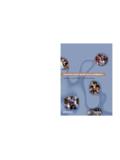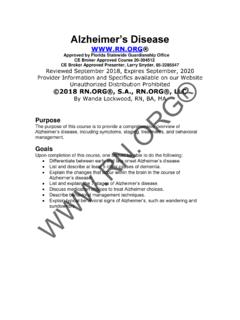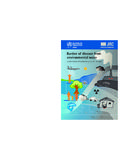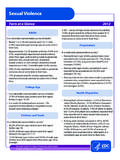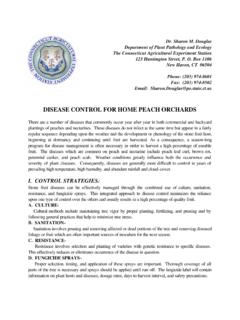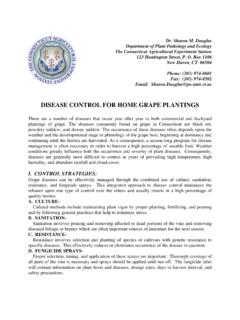Transcription of PESTE DES PETITS RUMINANTS - Home: OIE
1 PESTE DES PETITS RUMINANTS Aetiology Epidemiology Diagnosis Prevention and Control References AETIOLOGY Classification of the causative agent PESTE des PETITS ruminant virus (PPRV) classified in the family Paramyxoviridae, genus Morbillivirus. By means of nucleic acid sequencing, PPRV can be differentiated into four lineages (1 4). It is antigenically similar to rinderpest virus. Resistance to physical and chemical action Temperature: Half-life calculation of 2 hours/37 C; virus destroyed at 50 C/60 minutes pH: Stable between pH and ; thus inactivation at pH< or > Disinfectants/chemicals: Effective agents include alcohol, ether and common detergents; susceptible to most disinfectants, phenol, sodium hydroxide 2%/24 hours Survival: Survives for long periods in chilled and frozen tissues EPIDEMIOLOGY PESTE des PETITS RUMINANTS (PPR) represents one of the most economically important animal diseases in areas that rely on small RUMINANTS .
2 Outbreaks tend to be associated with contact of immuno-na ve animals with animals from endemic areas. In addition to occurring in extensive-migratory populations, PPR can occur in village and urban settings though the number of animals is usually too small to maintain the virus in these situations. Morbidity rate in susceptible populations can reach 90 100% Mortality rates vary among susceptible animals but can reach 50 100% in more severe instances Both morbidity and mortality rates are lower in endemic areas and in adult animals when compared to young Hosts Goats (predominantly) and sheep o Breed-linked predisposition in goats Wildlife host range not fully understood o documented disease in captive wild ungulates.
3 Dorcas gazelle (Gazelle dorcas), Thomson's gazelles (Gazella thomsoni), Nubian ibex (Capra ibex nubiana), Laristan sheep (Ovis gmelini laristanica) and gemsbok (Oryx gazella) Experimentally the American white-tailed deer (Odocoileus virginianus) is fully susceptible Cattle and pigs develop inapparent infections and do not transmit disease May be associated with limited disease events in camels Transmission Mainly by aerosols or direct contact between animals living in close quarters Fomites may be means of spreading infection; bedding, feed and water troughs No carrier state Seasonal variations: more frequent outbreaks during the rainy season or the dry cold season o Also associated with seasonal periods of increased local trade in goats Sources of virus Tears, nasal discharge, coughed secretions, and all secretions and excretions of incubating and sick animals Occurrence PPR was first described in C te d Ivoire, but it occurs in most African countries from North Africa to Tanzania, and in nearly all Middle Eastern countries up to Turkey.
4 PPR is also wide-spread in countries from central Asia to south and south-east Asia. Recent incursions into China (Tibet) and Morocco have caused serious disease outbreaks and disease has been reported to be moving southwards in East Africa. For more recent, detailed information on the occurrence of this disease worldwide, see the OIE World Animal Health Information Database (WAHID) Interface [ ] or refer to the latest issues of the World Animal Health and the OIE Bulletin. DIAGNOSIS The incubation period is typically 4 6 days, but may range from 3 10 days. For the purposes of the OIE Terrestrial Animal Health Code, the incubation period for the PPR is 21 days.
5 Clinical diagnosis disease severity depends on various factors: PPRV lineage, species, breed, immune status of animals. Various clinical manifestations of the disease have been described in the literature. Infected animals present clinical signs similar to those of rinderpest in cattle but with the eradication of this disease worldwide, its differentiation is of little or no importance. A tentative diagnosis of PPR can be made based on clinical signs, but this diagnosis is considered provisional until laboratory confirmation is made for differential diagnosis with other diseases with similar signs.
6 Two signs often seen in PPR and not in RP are crusting scabs along the lips and development of pneumonia in later stages of disease . Sheep and goats that recover from PPR develop an active immunity and antibodies have been demonstrated 4 years after infection; immunity is probably life-long. Acute form Sudden rise in body temperature (40 41 C) with effects on the general state: animals become depressed or restless, anorexic and develop a dry muzzle and dull coat o pyrexia can last for 3 5 days Serous nasal discharge becoming mucopurulent and resulting, at times, in a profuse catarrhal exudate which crusts over and occludes the nostrils.
7 Signs of respiratory distress o in surviving animals, mucopurulent discharge may persist for up to 14 days Within 4 days of onset of fever, gums become hyperaemic, and erosive lesions develop in the oral cavity with excessive salivation o necrotic stomatitis with halitosis is common o erosions may resolve or coalesce Small areas of necrosis on the visible mucous membranes Congestion of conjunctiva, crusting on the medial canthus and sometimes profuse catarrhal conjunctivitis Severe, watery, blood-stained diarrhoea is common in later stages Bronchopneumonia evidenced by coughing is a common feature; rales and abdominal breathing Abortions may occur Dehydration, emaciation, dyspnoea, hypothermia and death may occur within 5 10 days Survivors undergo long convalescence Peracute form Frequent in goats; especially situations of inmuno-na ve introductions into instances of circulating PPRV High fever, depression and death Higher mortality Subacute form Frequent in some areas because of local breed susceptibility.
8 Form commonly seen in experimentally infected animals Usually 10 15 days development with inconsistent signs; on or about 6th day post-infection, fever and serous nasal discharge is observed Fever falls with onset of diarrhoea and, if this is severe, may result in dehydration and prostration Lesions Lesions associated with PPR are very similar to those observed in cattle affected with rinderpest, except prominent crusty scabs along the outer lips and severe interstitial pneumonia frequently occur with PPR Emaciation, conjunctivitis, erosive stomatitis involving the inside of the lower lips and adjacent gum near the commisures and the free portion of the tongue Lesions on the hard palate.
9 Pharynx and upper third of the oesophagus in severe cases Rumen, reticulum and omasum rarely have lesions Small streaks of haemorrhages and sometimes erosions: in the first portion of the duodenum and the terminal ileum Necrotic or haemorrhagic enteritis with extensive necrosis and sometimes severe ulceration of Peyer's patches Congestion around the ileo-caecal valve, at the caeco-colic junction and in the rectum o Zebra stripes of congestion in the posterior part of the colon Small erosions and petechiae on the nasal mucosa, turbinates, larynx and trachea Bronchopneumonia is a constant lesion Possibility of pleuritis and hydrothorax Congestion and enlargement of spleen and liver Congestion.
10 Enlargement and oedema of most of the lymph nodes Erosive vulvovaginitis may exist Differential diagnosis Rinderpest Contagious caprine pleuropneumonia Bluetongue Pasteurellosis (also may occur as secondary infection to PPR) Contagious ecthyma Foot and mouth disease Heartwater Coccidiosis Mineral poisoning Laboratory diagnosis Samples Swabs of the conjunctival discharges and from the nasal and buccal mucosae For virus isolation, polymerase chain reaction (PCR) and haematology: o whole blood collected in EDTA; preferably collected in early stages of disease o blood and anticoagulant should be mixed gently For serologic needs, clotted blood can be collected at the end of an outbreak Upon necropsy aseptically collect the following tissues chilled on ice and transported under refrigeration o Lymph nodes (especially the mesenteric and bronchial nodes) o Spleen o Lung (especially intestinal mucosae) Set of tissues for histopathology should be placed in 10% neutral buffered formalin Procedures It should be noted that no live rinderpest virus can be permitted in any test system.











